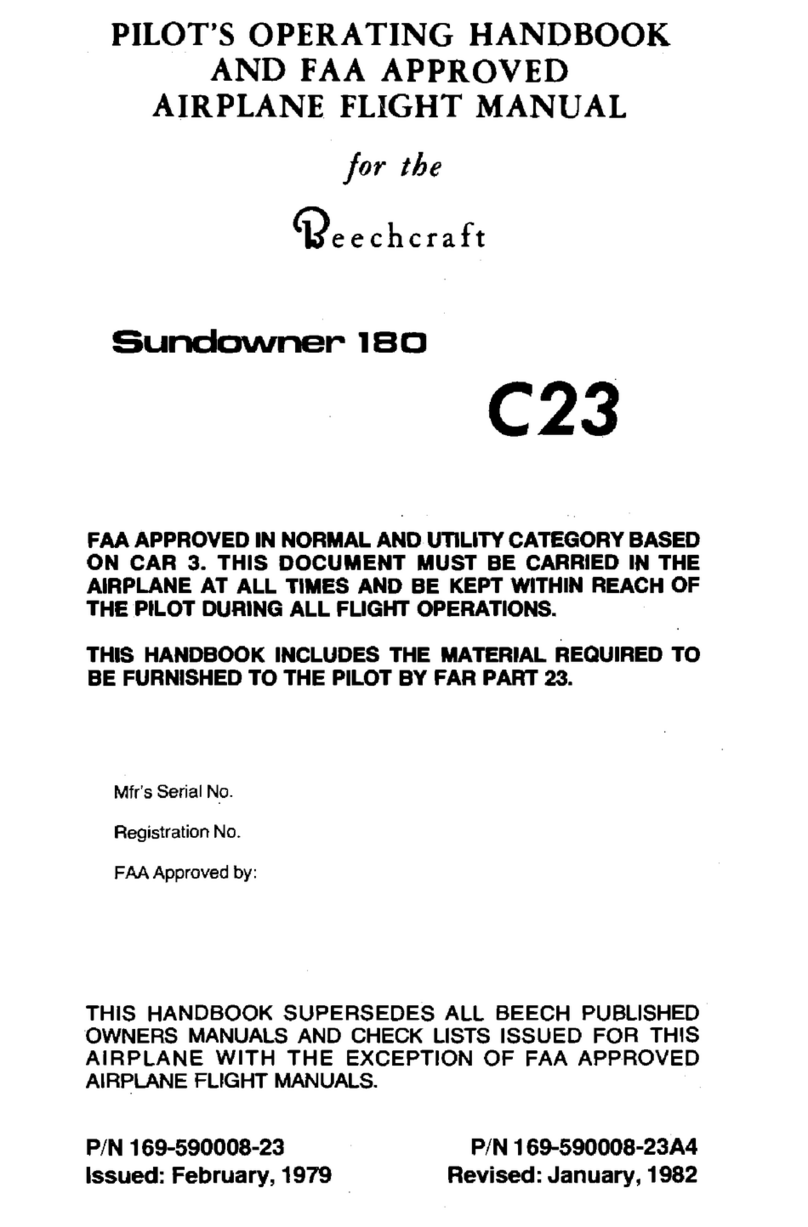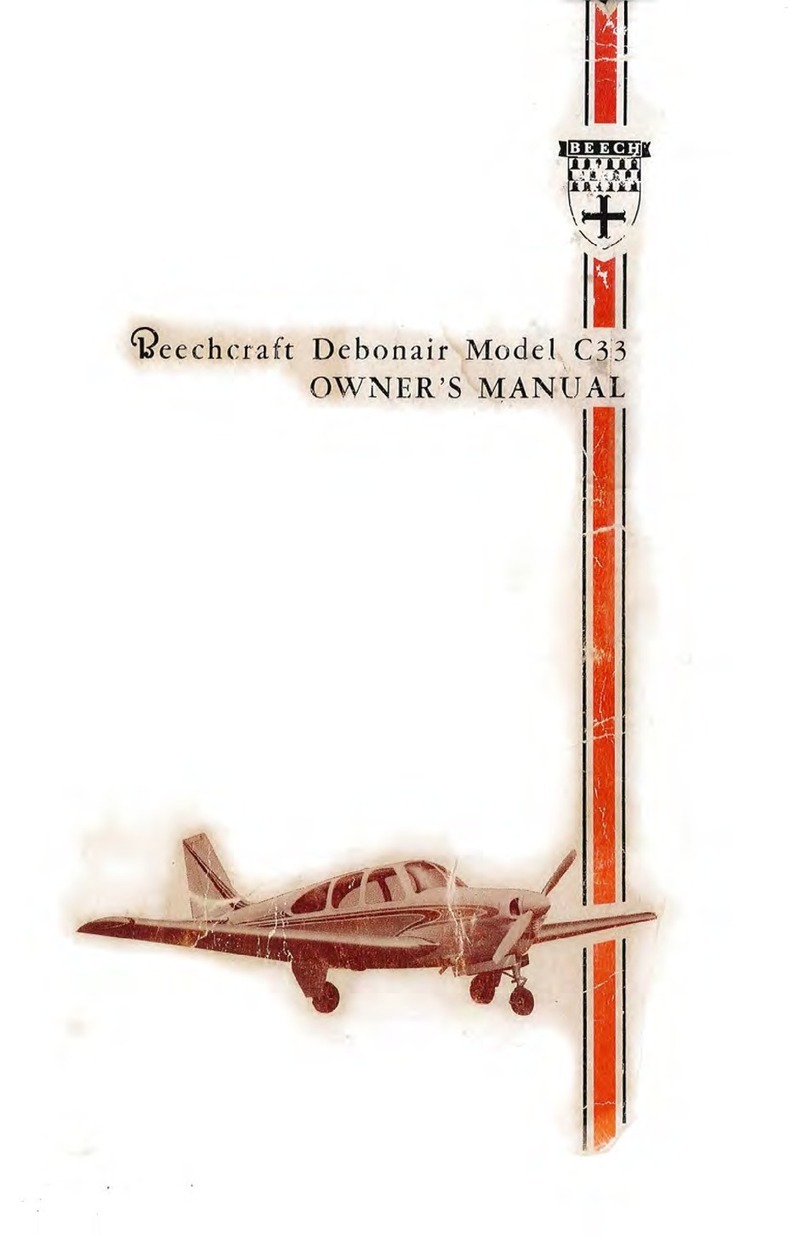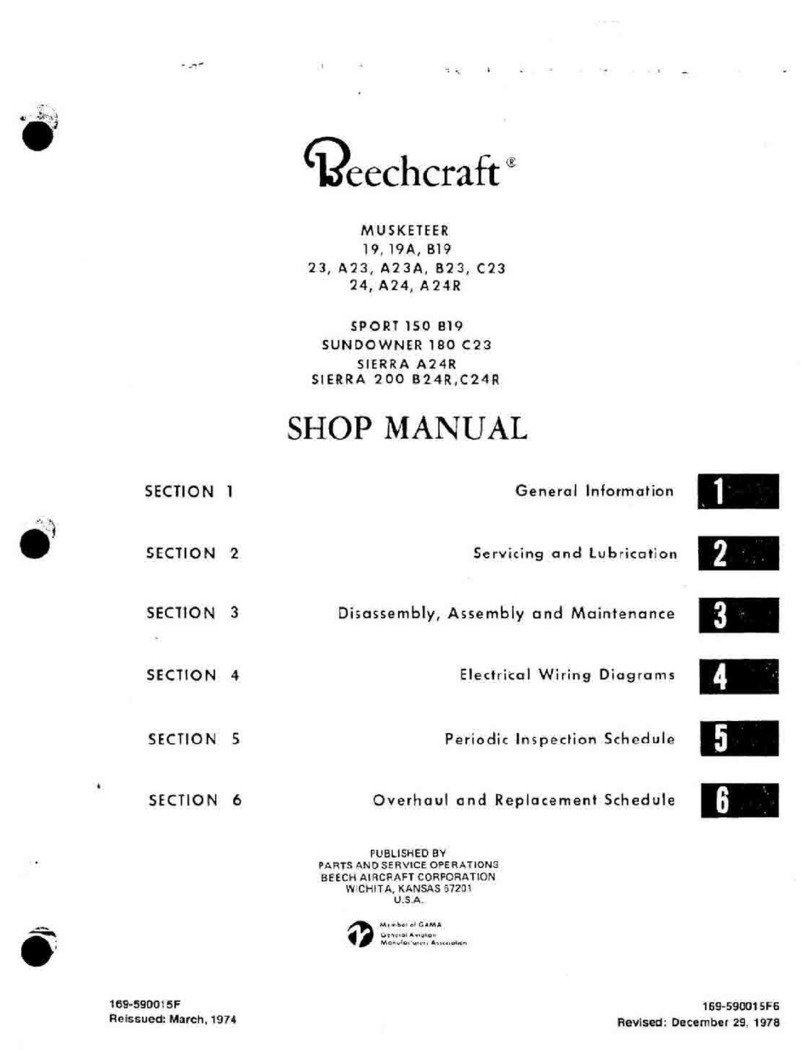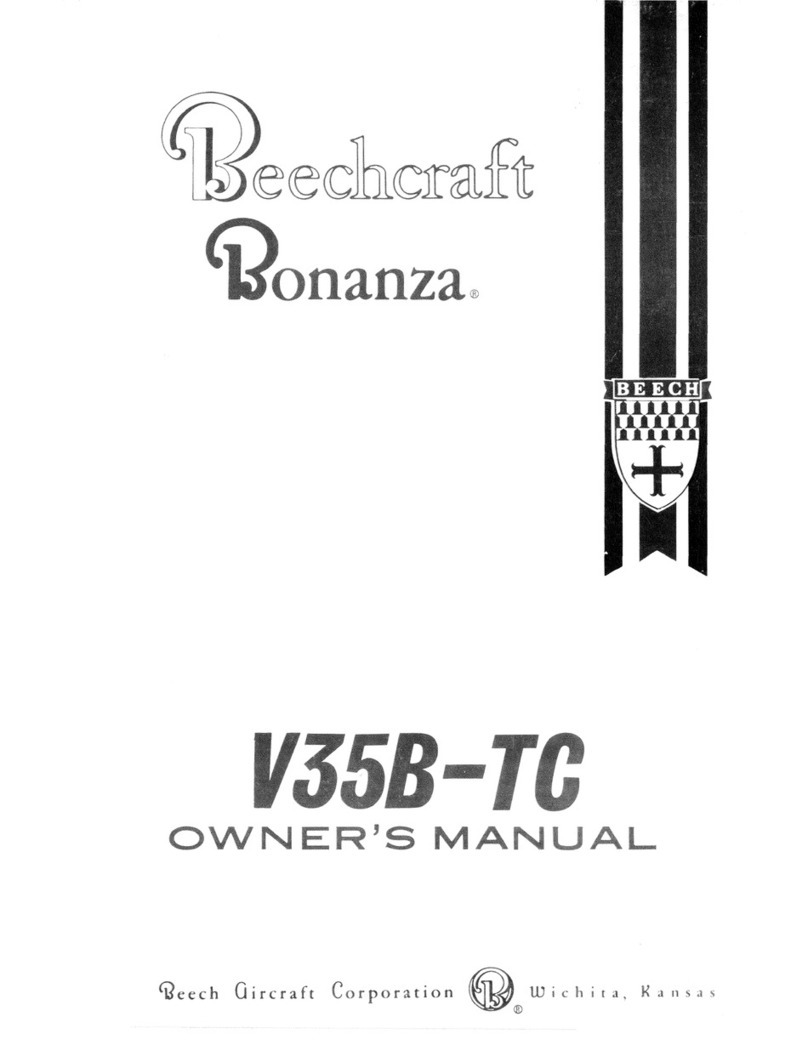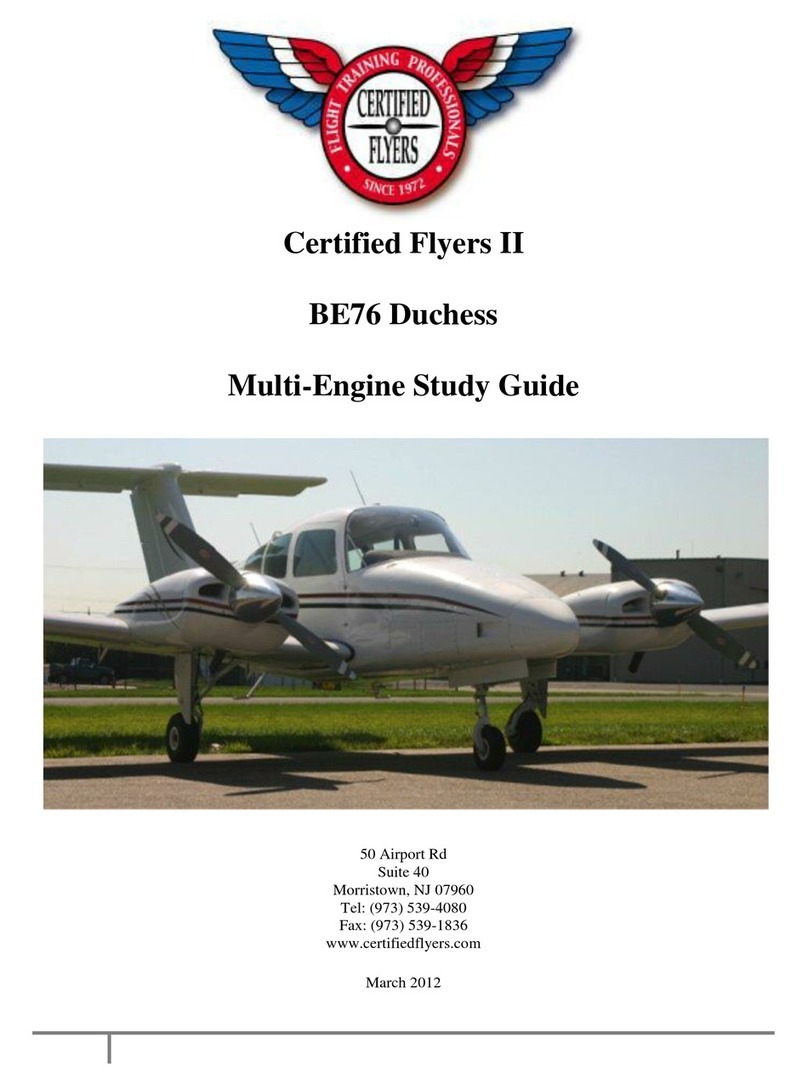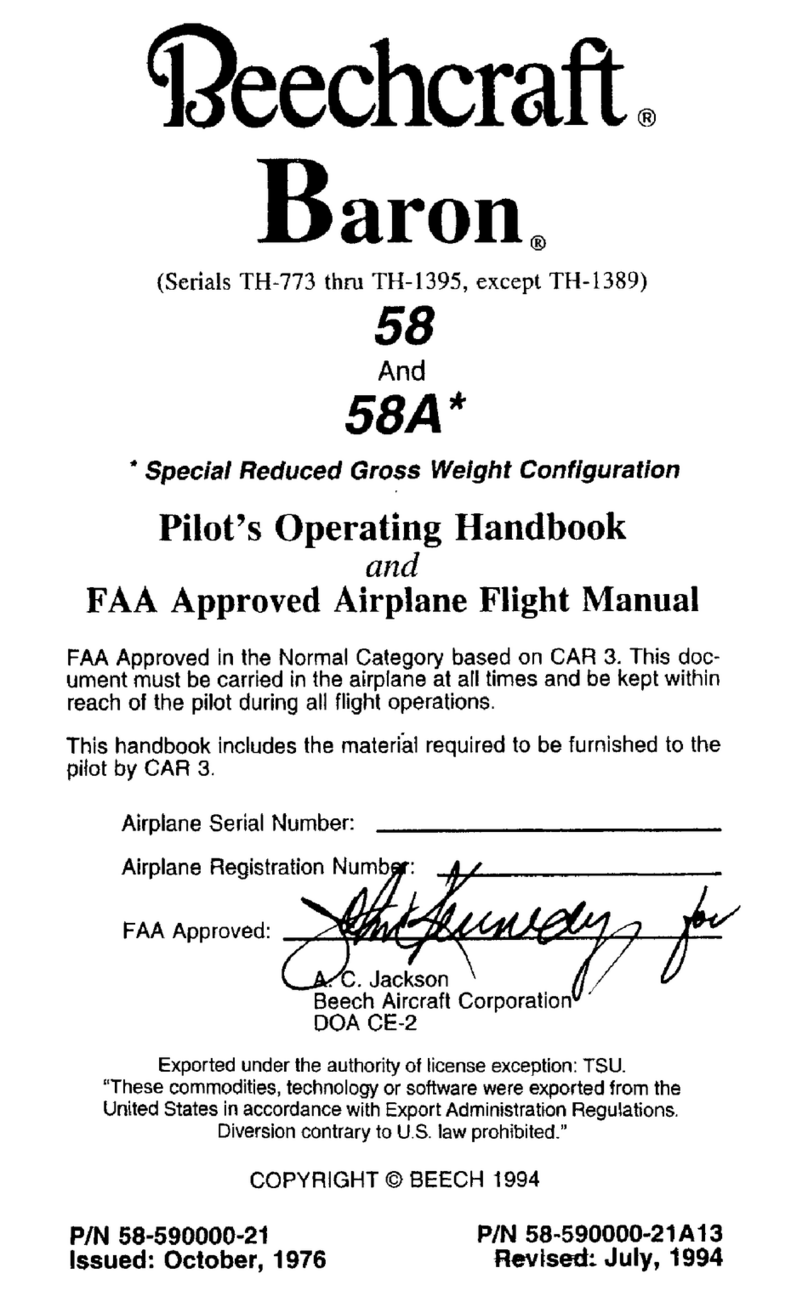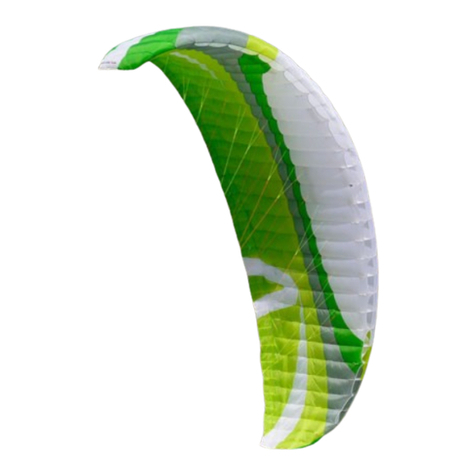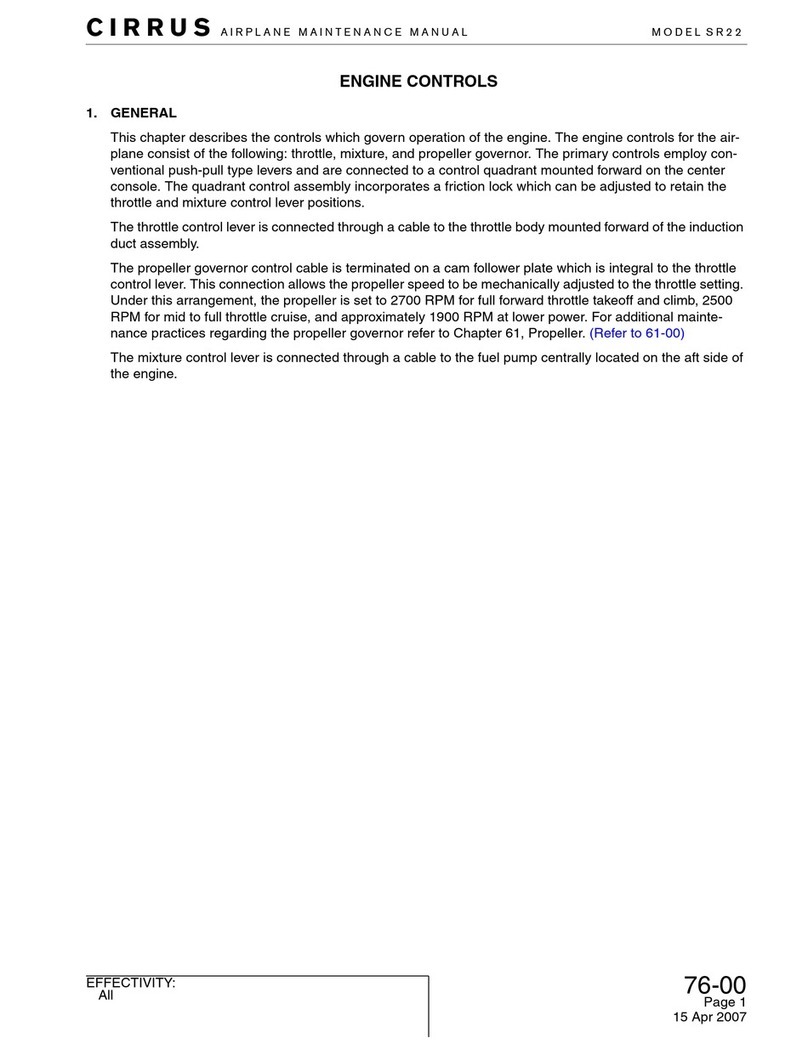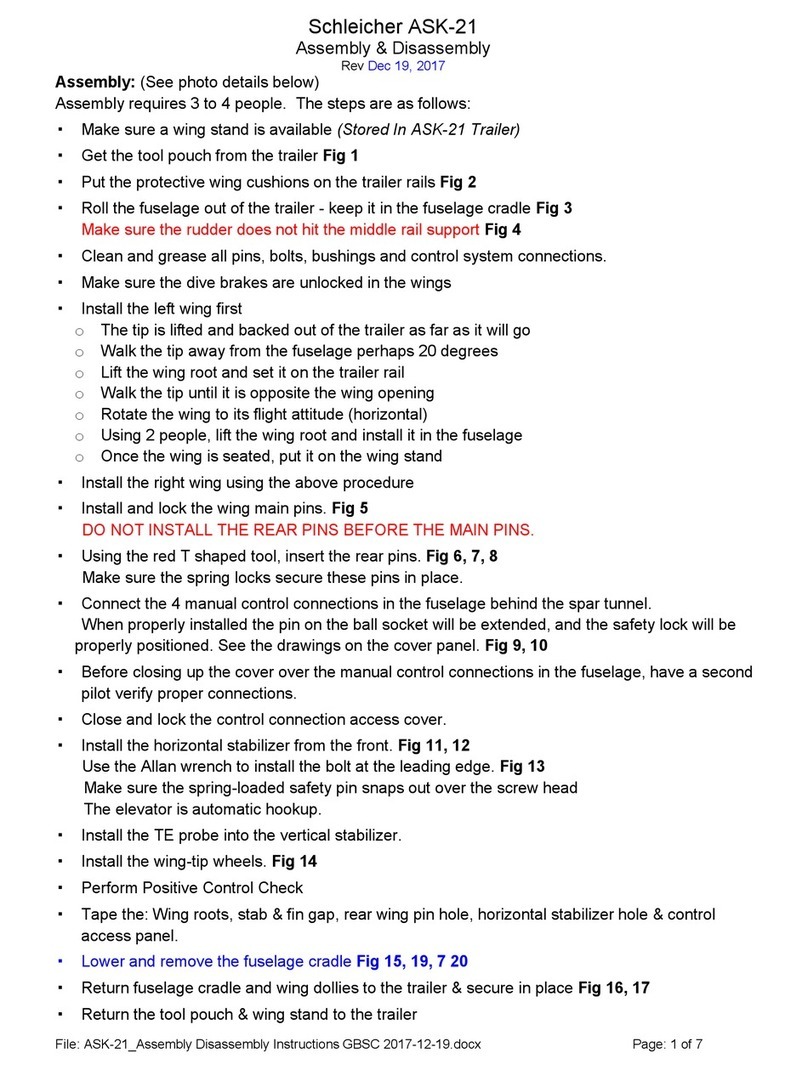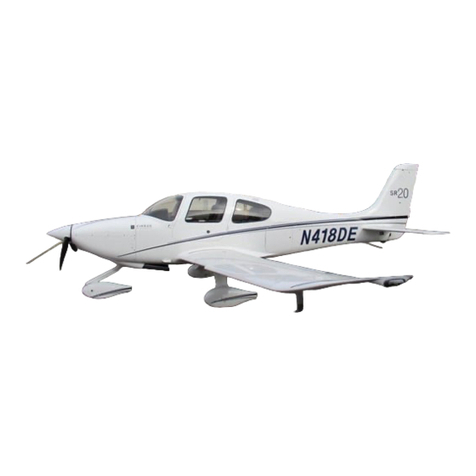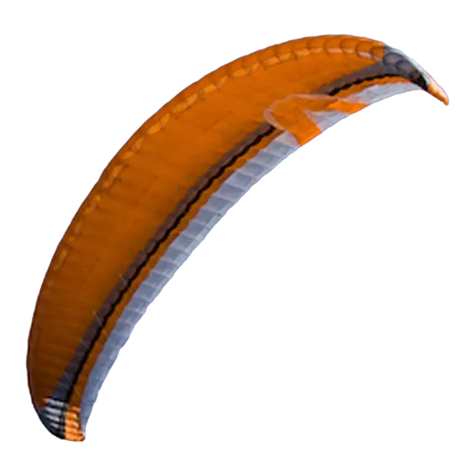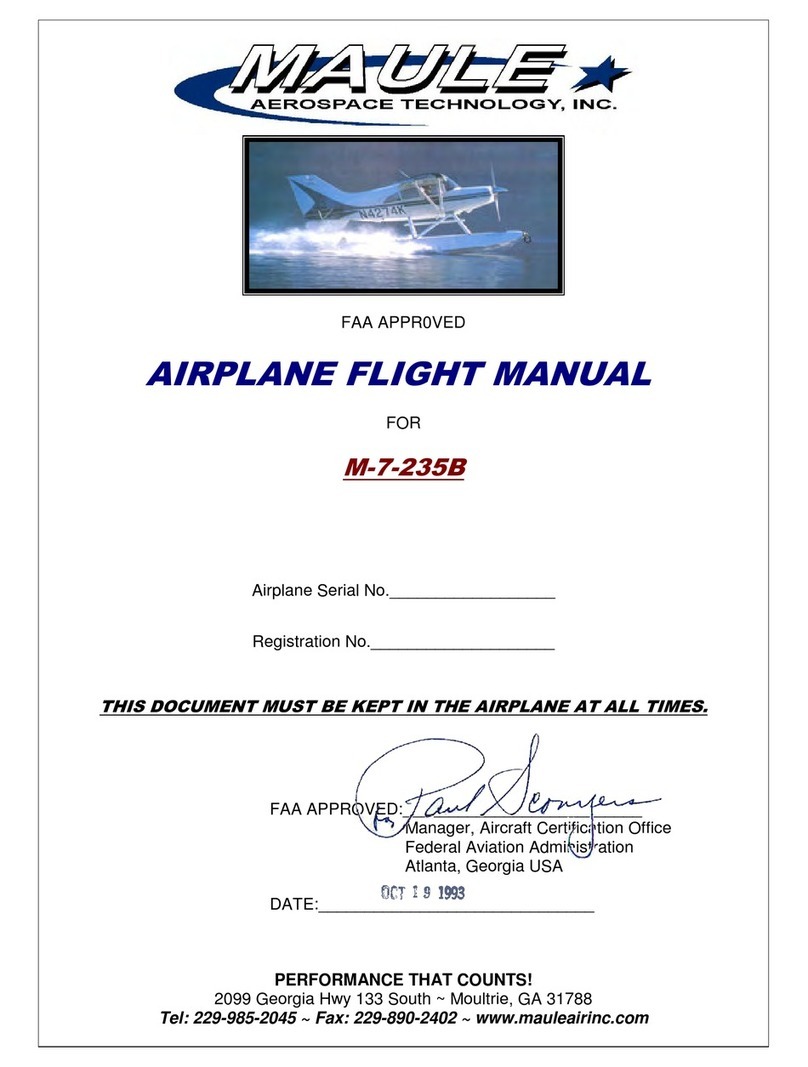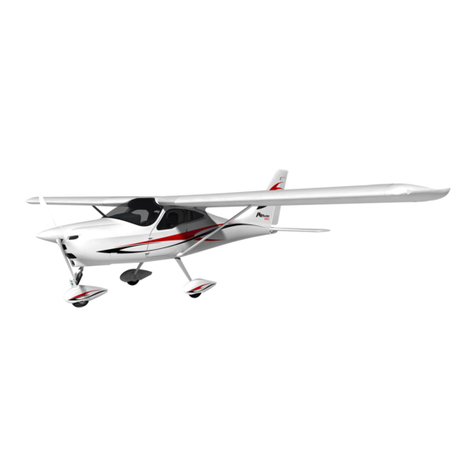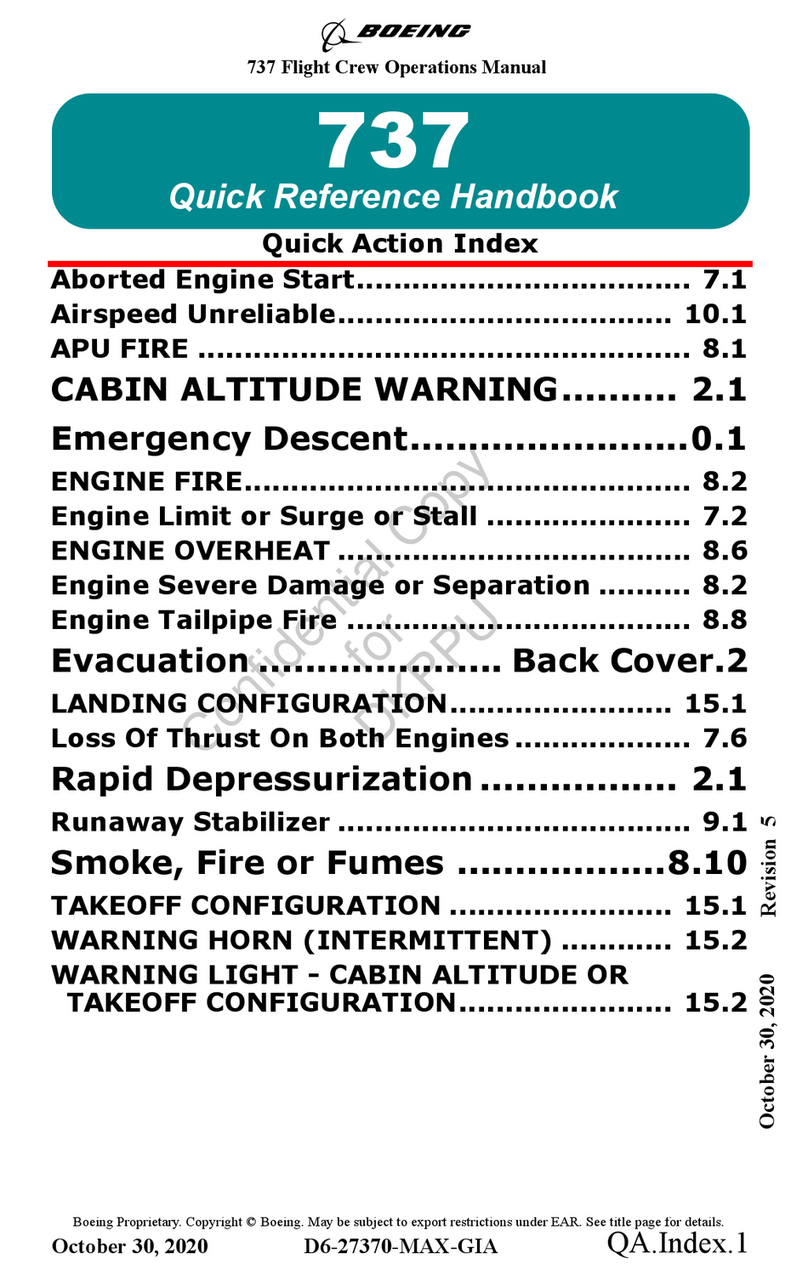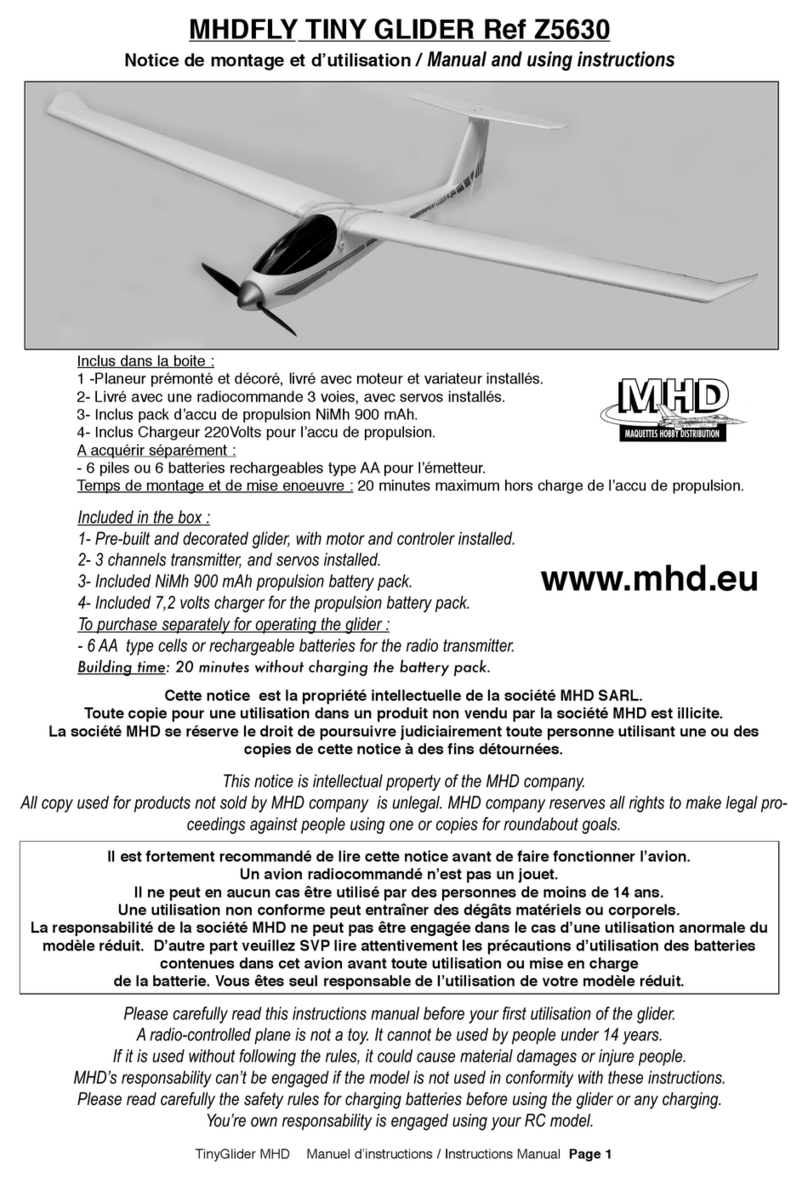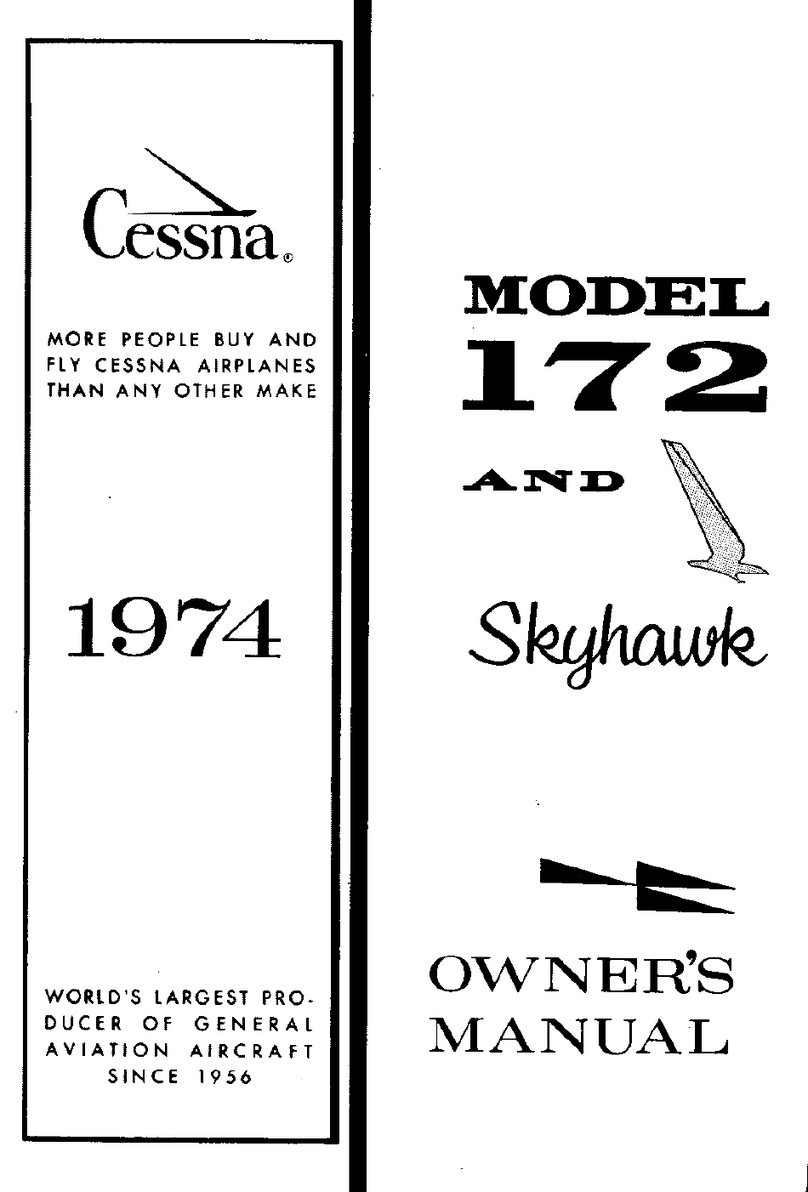Beechcraft Bonanza V35B Owner's manual


Beechcraft V35B Bonanza
Pilot Operating Handbook
-1-
BEECHCRAFT Bonanza V35B
THANK YOU ... for displaying confidence in us by selecting our V35B Bonanza for Microsoft Flight
Simulator. Our design and technical team have utilized their skills and years of experience to ensure
that the Bonanza meets the high standards of quality and performance for which FlightSim Developers
airplanes have become famous throughout the world.
IMPORTANT NOTICE
This handbook must be read carefully by the owner and operator in order to become familiar with the
operation of the V35B Bonanza. The handbook presents suggestions and recommendations to help
enhance your simulation experience and efficiently operate the aircraft.
EULA
All rights reserved per the terms of the End User License Agreement found at the end of this manual.
No part of this manual may be scanned, reproduced, copied, transmitted, distributed, downloaded or
used for any purpose without the express written consent of FSD International, Inc.
Information contained herein is subject to change without notice.
USE OF THE HANDBOOK
The Pilot's Operating Handbook is designed to maintain documents necessary for the safe and efficient
operation of the Bonanza.

Beechcraft V35B Bonanza
Pilot Operating Handbook
-2-
3-View Diagram

Beechcraft V35B Bonanza
Pilot Operating Handbook
-3-
Table of Contents
BEECHCRAFT Bonanza V35B.....................................................................................................1
Section I General .................................................................................................................5
DESCRIPTIVE DATA ...........................................................................................................5
ENGINE.........................................................................................................................5
PROPELLER....................................................................................................................5
FUEL.............................................................................................................................5
OIL CAPACITY ................................................................................................................5
WEIGHTS ......................................................................................................................5
CABIN DIMENSIONS ........................................................................................................5
BAGGAGE ......................................................................................................................5
Terminology And Symbols ...................................................................................................6
GENERAL AIRSPEED TERMINOLOGY ...................................................................................6
METEOROLOGICAL TERMINOLOGY .....................................................................................7
POWER TERMINOLOGY .....................................................................................................7
ENGINE CONTROLS AND INSTRUMENTS .............................................................................7
WEIGHT AND BALANCE TERMINOLOGY ...............................................................................8
Section II Limitations ..........................................................................................................10
AIRSPEED LIMITATIONS ...................................................................................................10
AIRSPEED INDICATOR MARKINGS ...................................................................................10
POWER PLANT LIMITATIONS..............................................................................................11
ENGINE.......................................................................................................................11
FUEL...........................................................................................................................11
OIL.............................................................................................................................11
PROPELLER..................................................................................................................11
POWER PLANT INSTRUMENT MARKINGS ...........................................................................12
WEIGHT AND CENTER OF GRAVITY ..................................................................................12
APPROVED MANEUVERS (2650 POUNDS) ..........................................................................13
FLIGHT LOAD FACTORS (2650 POUNDS) ...........................................................................13
REQUIRED EQUIPMENT FOR VARIOUS CONDITIONS OF FLIGHT ............................................13
Emergency Procedures ........................................................................................................14
EMERGENCY AIRSPEEDS...................................................................................................14
ENGINE FIRE (GROUND) ...................................................................................................14
ENGINE FAILURE ON TAKE-OFF..........................................................................................14
ENGINE MALFUNCTION IN FLIGHT ......................................................................................14
ENGINE FAILURE ..........................................................................................................14
DISCREPANCY CHECKS ..................................................................................................14
AIR START PROCEDURE .................................................................................................15
ENGINE FIRE (FLIGHT) ..................................................................................................15
EMERGENCY DESCENT ...................................................................................................15
MAXIMUM GLIDE CONFIGURATION.....................................................................................16
EMERGENCY LANDING......................................................................................................16
GEAR-UP LANDING........................................................................................................16
UNLATCHED DOOR IN FLIGHT .........................................................................................16
GENERATOR OUT PROCEDURE ...........................................................................................16
SPINS............................................................................................................................16
INDUCTION SYSTEM ICING ...............................................................................................17
EMERGENCY SPEED REDUCTION ........................................................................................17
Normal Procedures .............................................................................................................18
SPEEDS FOR SAFE OPERATION ..........................................................................................18

Beechcraft V35B Bonanza
Pilot Operating Handbook
-4-
PREFLIGHT INSPECTION...................................................................................................18
BEFORE STARTING ..........................................................................................................18
STARTING......................................................................................................................19
BEFORE TAKE-OFF...........................................................................................................20
TAKE-OFF.......................................................................................................................20
CLIMB ...........................................................................................................................20
CRUISE..........................................................................................................................20
DESCENT .......................................................................................................................21
BEFORE LANDING............................................................................................................21
SHUTDOWN....................................................................................................................21
Systems Description ...........................................................................................................22
TRIM CONTROL ...............................................................................................................22
WING FLAPS ...................................................................................................................22
INSTRUMENT PANEL ........................................................................................................22
ENGINE INSTRUMENTS.....................................................................................................24
MANIFOLD PRESSURE GAUGE AND TACHOMETER...............................................................24
ENGINE CONTROLS..........................................................................................................25
THROTTLE, MIXTURE AND PROPELLER..............................................................................25
COWL FLAPS ................................................................................................................25
OIL SYSTEM.................................................................................................................25
STARTER.....................................................................................................................26
PROPELLER..................................................................................................................27
FUEL SYSTEM...............................................................................................................27
FUEL QUANTITY............................................................................................................28
FUEL TANK SELECTION ..................................................................................................28
FUEL REQUIRED FOR FLIGHT ..........................................................................................29
LANDING GEAR SYSTEM ...................................................................................................29
CONTROL SWITCH ........................................................................................................29
POSITION INDICATORS..................................................................................................29
WARNING HORN...........................................................................................................29
BRAKES.......................................................................................................................29
GROUND CONTROL .......................................................................................................30
ELECTRICAL SYSTEM........................................................................................................30
GENERATOR.................................................................................................................30
LIGHTING SYSTEM...........................................................................................................31
INTERIOR LIGHTING......................................................................................................31
EXTERIOR LIGHTING .....................................................................................................31
HEATING AND VENTILATION SYSTEM CABIN HEATING...........................................................31
PITOT AND STATIC SYSTEM ..............................................................................................33
VACUUM SYSTEM.............................................................................................................33
STALL WARNING .............................................................................................................33
Performance......................................................................................................................34
INTRODUCTION TO PERFORMANCE AND FLIGHT PLANNING....................................................34

Beechcraft V35B Bonanza
Pilot Operating Handbook
-5-
Section I General
DESCRIPTIVE DATA
ENGINE
The V35B Bonanza is powered by either a Continental E185-1 or E185-8 six cylinder engine rated for a
maximum take-off power of 185 hp at 2300 rpm (max. one minute). The maximum continuous rating is
165 hp at 2050 rpm.
PROPELLER
Beech electrically controlled variable pitch, two blade, 88¬inch diameter propeller with Beech pitch
control motor and spinner. The propeller uses a Beech R203-100 hub with either R201-217-88 or R203-
218-88 blades.
FUEL
Aviation Gasoline 80/87 (red) minimum grade or alternate grades 100LL (blue) or 100/130 (green).
Standard fuel system: Two 20-gallon tanks in wings. Total 34 gallons usable.
Optional fuel system: Two 20 gallon main tanks in wings and either one 10 gallon or one 20 gallon
auxiliary tank installed in the baggage compartment. All of the capacity of the 10 gallon tank is usable.
The 20 gallon tank adds 19 gallons usable fuel to the system.
OIL CAPACITY
The oil capacity is 10 quarts.
WEIGHTS
Maximum Ramp Weight 2660 lbs
Maximum Take-Off Weight 2650 lbs
Maximum Landing Weight 2650 lbs
CABIN DIMENSIONS
Length 6 ft 11 in.
Height 4 ft 2 in,
Width 3 ft 6 in.
Entrance Door 36 in. x 37 in.
BAGGAGE
Volume 16.5 cu ft
Capacity 270 lbs
Baggage Door 22.5 in. x 18.5 in.

Beechcraft V35B Bonanza
Pilot Operating Handbook
-6-
TERMINOLOGY AND SYMBOLS
GENERAL AIRSPEED TERMINOLOGY
CAS Calibrated Airspeed is the indicated speed of an airplane, corrected for position and
instrument error. Calibrated airspeed is equal to true airspeed in standard atmosphere at sea
level.
GS Ground Speed is the speed of an airplane relative to the ground
IAS Indicated Airspeed is the speed of an airplane as shown on the airspeed indicator when
corrected for instrument error. IAS values published in this handbook assume zero
instrument error.
KCAS Calibrated Airspeed expressed in "knots".
KIAS Indicated Airspeed expressed in "knots".
TAS True Airspeed is the airspeed of an airplane relative to undisturbed air which is the CAS
corrected for altitude, temperature, and compressibility.
VAManeuvering Speed is the maximum speed at which application of full available aerodynamic
control will not overstress the airplane.
VFE Maximum Flap Extended Speed is the highest speed permissible with wing flaps in a
prescribed extended position.
VLE Maximum Landing Gear Extended Speed is the maximum speed at which an airplane can be
safely flown with the landing gear extended.
VLO Maximum Landing Gear Operating Speed is the maximum speed at which the landing gear
can be safely extended or retracted.
VNE Never Exceed Speed is the speed limit that may not be exceeded at any time.
VNO Maximum Structural Cruising Speed is the or Vc speed that should not be exceeded except in
smooth air and then only with caution.
Vs Stalling Speed or the minimum steady flight speed at which the airplane is controllable.
VSO Stalling Speed or the minimum steady flight speed at which the airplane is controllable in the
landing configuration.
VXBest Angle-of-Climb Speed is the airspeed which delivers the greatest gain ot altitude in the
shortest possible horizontal distance.
Vy Best Rate-of-Climb Speed is the airspeed which delivers the greatest gain in altitude in the
shortest possible time.

Beechcraft V35B Bonanza
Pilot Operating Handbook
-7-
METEOROLOGICAL TERMINOLOGY
ISA International Standard Atmosphere in which
(1) The air is a dry perfect gas;
(2) The temperature at sea level is 15° Celsius (59° Fahrenheit);
(3) The pressure at sea level is 29.92 inches Hg. (1013.2 millibars);
(4) The temperature gradient from sea level to the altitude at which the temperature is -56.5° C (-
69.7° F) is -0.00198° C (-0.003566° F) per foot and zero above that altitude.
OAT Outside Air Temperature is the free air static temperature obtained either from in-flight
temperature indications adjusted for instrument error and compressibility effects, or ground
meteorological sources.
Indicated
Pressure
Altitude
The number actually read from an altimeter when the barometric sub¬scale has been set to
29.92 inches of mercury (1013.2 millibars).
Pressure
Altitude
Altitude measured from standard sea-level pressure (29.92 in. Hg) by a pressure or
barometric altimeter.
Station
Pressure
It is the indicated pressure altitude corrected for position and instrument error. In this
Handbook, altimeter instrument errors are assumed to be zero. Position errors may be
obtained from the Altimeter Correction Chart. Actual atmospheric pressure at field elevation.
Wind
The wind velocities recorded as variables on the charts of this handbook are to be understood
as the headwind or tailwind components of the reported winds.
POWER TERMINOLOGY
Take off
Maximum power rating, limited by time.
Maximum
Continuous
Highest power rating not limited by time.
Cruise
Climb
Power recommended for cruise climb.
ENGINE CONTROLS AND INSTRUMENTS
Throttle
Control
Used to control power by introducing fuel-air mixture into the intake passages of the
engine. Settings are reflected by readings on the manifold pressure gauge.
Mixture
Control
This control is used to set fuel to air ratio in all modes of operation
and cuts off fuel completely for engine shut down.
EGT Exhaust Gas Temperature Indicator. This indicator is used to identify the lean and best
power fuel/air mixtures for various power settings.
Tachometer
Indicates the rpm of the engine/ propeller.
ADI Automatic Direction Indicator (artificial horizon)
RMI Radio Magnetic Indicator

Beechcraft V35B Bonanza
Pilot Operating Handbook
-8-
WEIGHT AND BALANCE TERMINOLOGY
Reference
Datum
An imaginary vertical plane from which all horizontal distances are measured for balance
purposes.
Station
A location along the airplane fuselage usually given in terms of distance from the reference
datum.
Arm
The horizontal distance from the reference datum to the center of gravity (C.G.) of an item.
Moment
The product of the weight of an item multiplied by its arm. (Moment divided by a constant is
used to simplify balance calculations by reducing the number of digits.)
Airplane
Center of
Gravity
(C. G.)
The point at which an airplane would balance if suspended. Its distance from the reference
datum is found by dividing the total moment by the total weight of the airplane.
C.G. Arm
The arm obtained by adding the airplane’s individual moments and dividing the sum by the
total weight.
C.G.
Limits
The extreme center of gravity locations within which the airplane must be operated at a
given weight.
Usable
Fuel
Fuel available for flight planning.
Unusable
Fuel Fuel remaining after a runout test has been completed in accordance with governmental
regulations.
Standard
Empty
Weight
Weight of a standard airplane including unusable fuel, full operating flu ids and full oil.
Basic
Empty
Weight
Standard empty weight plus optional equipment.
Payload
Weight of occupants, cargo and baggage.
Useful
Load Difference between take off weight, or ramp weight if applicable, and basic empty weight.
Maximum
Ramp
Weight
Maximum weight approved for ground maneuvering. (It includes weight of start, taxi, and
run up fuel).
Maximum
Take-off
Weight
Maximum weight approved for the start of the take off run.

Beechcraft V35B Bonanza
Pilot Operating Handbook
-9-
Maximum
Landing
Weight
Maximum weight approved for the landing touchdown.
Zero Fuel
Weight
Weight exclusive of usable fuel.
This space left intentionally blank

Beechcraft V35B Bonanza
Pilot Operating Handbook
-10 -
Section II Limitations
The limitations included in this section have been approved by the Federal Aviation Administration.
The following limitations must be observed In the operation of this airplane.
AIRSPEED LIMITATIONS
CAS IAS
SPEED KNOTS
MPH KNOTS
MPH REMARKS
Never Exceed
VNE 176 202 177 204 Do not exceed this speed in
any operation
Maximum Structural
Cruising VNO or Vc 139 160 140 161 Do not exceed this speed
except in smooth air and then
only with caution
Maneuvering
VA 113 130 114 131 Do not make full
or abrupt control
movements above
this speed
Maximum Flap
Extension/Extended
VFE
91 105
91 105 Do not extend flaps or operate
with flaps extended above
this speed
Maximum Landing
Gear Operating!
Extended VLO and VLE
109 125 110 127
Do not extend, retract or operate
with landing gear extended
above this speed except in
emergency
AIRSPEED INDICATOR MARKINGS
CAS IAS
MARKING KNOTS MPH KNOTS MPH SIGNIFICANCE
White Arc
49-91 56-105
45-91 52-105
Full Flap Operating Range
Green Arc
58-139
67-160
54-140
62-161
Normal Operating Range
Yellow Arc
139-176
160-202
140-1 77
161-204
Operate with caution only in
smooth air
Red Line
176 202 177 204
Maximum speed for ALL operations

Beechcraft V35B Bonanza
Pilot Operating Handbook
-11 -
POWER PLANT LIMITATIONS
ENGINE
A35 Continental E 185-1 or E 185-8
Take-off
(one minute) ………………………………… 2300 rpm, Full throttle
Maximum continuous
operation ……………………………………… 2050 rpm, Full throttle
B35 Continental E185-8 (S/N 51220 and above)
Take-off
(one minute)………………………………… 2450 rpm, Full throttle
Maximum continuous
operation …………………………………….. 2050 rpm, Full throttle
NOTE
Other engines are approved for this model Bonanza but not
installed as original equipment. These are listed in the FAA
Aircraft Specification A-777 or approved by Supplemental
Type Certificate.
FUEL
Aviation Gasoline 80/87 (red) minimum grade or alternate grades 100LL (blue) or 100/130 (green). See
Engine Manufacturer's Bulletin.
OIL
Ashless dispersant oils must meet Continental Motors Corporation Specification MHS-24A.
PROPELLER
Beech -two blade. 88 inch diameter (max.) propeller.

Beechcraft V35B Bonanza
Pilot Operating Handbook
-12 -
POWER PLANT INSTRUMENT MARKINGS
OIL TEMPERATURE
Caution (Yellow Radial) 100°F/38°C
Operating Range (Green Arc) 100° to 225°F/38° to 107°C
Maximum (Red Radial) 225°F/107°C
OIL PRESSURE
Minimum Pressure (Red Radial) 30 psi
Operating Range (Green Arc) 30 to 60 psi
Maximum Pressure (Red Radial) 80 psi
TACHOMETER
Operating Range (Green Arc) 1300 to 2050 rpm
Cautionary Range (Yellow Arc) 2050 to 2300 rpm
Maximum RPM (Red Radial) 2300 rpm
CYLINDER HEAD TEMPERATURE
Operating Range (Green Arc) 300° to 460°Fj149° to 238°C
Maximum Temperature (Red Radial) 525°F;274°C
MANIFOLD PRESSURE
Operating Range (Green Arc) 15 to 29.6 in. Hg
Maximum (Red Radial) 29.6 in. Hg
FUEL PRESSURE
Minimum (Red Radial) 9 psi
Operating Range (Green Arc) 11 to 14 psi
Maximum (Red Radial) 14 psi
WEIGHT AND CENTER OF GRAVITY
Maximum Take-off and Landing Weight 2650 lbs
Maximum Ramp Weight 2660 lbs
Zero Fuel Weight No Structural Limitation
Datum is 83.1 inches forward of center line through forward jack points.
MAC leading edge is 66.7 inches aft of datum. MAC length is 65.3 inches.
CG LIMITS (Gear Down)
Forward: 75.9 inches aft of datum to 2140 lbs with straight line
variation to 83.7 inches at 2650 lbs.
Aft: 85.4 inches aft of datum to 2405 lbs with straight line
variation to 84.4 inches at 2650 lbs.

Beechcraft V35B Bonanza
Pilot Operating Handbook
-13 -
APPROVED MANEUVERS (2650 POUNDS)
MANEUVER ENTRY SPEED (CAS)
Chandelle 113 kts/130 mph
Steep Turn 113 kts/130 mph
Lazy Eight 113 kts/130 mph
Stall (Except Whip) Use slow deceleration
Spins are prohibited.
FLIGHT LOAD FACTORS (2650 POUNDS)
4.4G positive maneuvering load factor with flaps up. 2.0G positive maneuvering load factor with flaps
down.
REQUIRED EQUIPMENT FOR VARIOUS CONDITIONS OF FLIGHT
Federal Aviation Regulations (91.3(a), 91.24, 91.25, 91.32, 91.33, 91.52, 91.90, 91.97,91.170) specify
the minimum numbers and types of airplane instruments and equipment which must be installed and
operable for various kinds of flight conditions. This includes VFR day, VFR night, IFR day, and IFR night.
Regulations also require that all airplanes be certificated by the manufacturer for operations under
various flight conditions. At certification, all required equipment must be in operating condition and
should be maintained to assure continued airworthiness. If deviations from the installed equipment were
not permitted, or if the operating rules did not provide for various flight conditions, the airplane could
not be flown unless all equipment was operable. With appropriate limitations. the operation of every
system or component installed in the airplane is not necessary, when the remaining operative
instruments and equipment provide for continued safe operation. Operation in accordance with
limitations established to maintain airworthiness, can permit continued or uninterrupted operation of the
airplane temporarily.
For the sake of brevity, the Required Equipment Listing does not include obviously required items such
as wings, rudders, flaps, engine, landing gear, etc. Also the list does not include items which do not
affect the airworthiness of the aircraft such as galley equipment, entertainment systems, passenger
convenience items, etc. However, it is important to note that ALL ITEMS WHICH ARE RELATED TO THE
AIRWORTHINESS OF THE AIRPLANE AND NOT INCLUDED ON THE LIST ARE AUTOMATICALLY REQUIRED
TO BE OPERATIVE.
To enable the pilot to rapidly determine the FAA equipment requirements necessary for a flight into
specific conditions, the following equipment requirements and exceptions are presented. It is the final
responsibility of the pilot to determine whether the lack of, or inoperative status of a piece of equipment
on his airplane, will limit the conditions under which he may operate the airplane.
NOTE
FLIGHT IN KNOWN ICING CONDITIONS PROHIBITED.

Beechcraft V35B Bonanza
Pilot Operating Handbook
-14 -
Emergency Procedures
EMERGENCY AIRSPEEDS
Emergency Descent 110 kts/127 mph
Glide 105 kts/121 mph
Emergency Landing
Approach 70-76 kts/81-87 mph
All airspeeds quoted in this section are indicated airspeeds (IAS).
The following information is presented to enable the pilot to form, in advance, a definite plan of action
for coping with the most probable emergency situations which could occur in the operation of the
airplane. Where practicable, the emergencies requiring immediate corrective action are treated in check
list form for easy reference and familiarization. Other situations, in which more time is usually permitted
to decide on and execute a plan of action, are discussed at some length.
ENGINE FIRE (GROUND)
1. Mixture -IDLE CUT-OFF
2. Fuel Selector Valve -OFF
3. Battery, Generator and Ignition Switches -OFF
4. Extinguish with Fire Extinguisher.
ENGINE FAILURE ON TAKE-OFF
DURING GROUND ROLL
1. Throttle -CLOSED
2. Braking -MAXIMUM
3. Fuel Selector Valve -OFF
4. Battery and Generator Switches -OFF
If airborne and insufficient runway remains for landing:
1. Fuel Selector Valve -SELECT OTHER MAIN TANK
2. Auxiliary (Wobble) Fuel Pump -PUMP (9 TO 10 P.S.I.)
3. Mixture -FULL RICH
4. Ignition -CHECK, ON BOTH
IF NO RESTART
1. Select most favorable landing site.
2. See EMERGENCY LANDING procedure.
3. The use of landing gear is dependent on the terrain where landing must be made.
ENGINE MALFUNCTION IN FLIGHT
ENGINE FAILURE
The most probable cause of engine failure would be loss of fuel flow or improper functioning of the
ignition system.
DISCREPANCY CHECKS
(Rough running engine, loss of engine power, loss of fuel flow, etc.)
1. Rough Running Engine
a. Mixture -FULL RICH, then lean as required
b. Ignition Switch -CHECK on BOTH position

Beechcraft V35B Bonanza
Pilot Operating Handbook
-15 -
2. Loss of Power
a. Fuel Pressure Gage -CHECK (fuel pressure abnormally low)
(1) Mixture -FULL RICH
(2) Auxiliary (Wobble) Fuel Pump -MAINTAIN FUEL PRESSURE
(3) Auxiliary (Wobble) Fuel Pump -STOP if performance does not improve in a few moments
b. Fuel Quantity Indicator -CHECK (fuel tank being used is empty)
(1) Select other tank (check to feel detent)
c. Carburetor Heat -Pull full carburetor heat and check for manifold pressure drop. Push
carburetor heat to cold position -manifold pressure should return to original position.
3. Propeller Overspeed
a. Retard throttle to reduce RPM to red line.
b. Propeller switch to manual LO RPM.
c. Reduce speed to assist in maintaining altitude.
d.Select nearest landing site, follow emergency landing procedures.
AIR START PROCEDURE
a. Mixture -IDLE CUT-OFF
b. Fuel Selector Valve -OFF to clear engine then TO MAIN TANK MORE NEARLY FULL
NOTE
If the failure was due to the fuel metering valve sticking in the full open position, the carburetor will
deliver an excess of fuel, with constant flooding. Shutting off fuel momentarily will clear the engine and
may restore normal operation by allowing the spring in the carburetor to reseat the valve.
c. Throttle -1/4 INCH OPEN
d. Mixture -FULL RICH
e. Auxiliary (Wobble) Fuel Pump -MAINTAIN FUEL PRESSURE
f. Throttle -ADVANCE to desired power
ENGINE FIRE (FLIGHT)
The red VENT SHUTOFF control on the outboard side of the right lower subpanel is used to close off all
heating system outlets so that smoke and fumes will not enter the cabin. In the event of engine fire,
shut down the engine as follows and make a landing:
1. Vent Shutoff Control -PULL TO CLOSE
2. Mixture -IDLE CUT-OFF
3. Fuel Selector Valve -OFF
4. Battery, Generator, and Ignition Switches -OFF (Extending the landing gear can be
accomplished manually if desired.)
5. Do not attempt to restart engine.
EMERGENCY DESCENT
1. Power -IDLE
2. Propeller -HI RPM
3. Landing Gear -DOWN
4. Airspeed -ESTABLISH 110 kts/127 mph

Beechcraft V35B Bonanza
Pilot Operating Handbook
-16 -
MAXIMUM GLIDE CONFIGURATION
1. Landing Gear -UP
2. Flaps -UP
3. Cowl Flaps -CLOSED
4. Propeller -LO RPM
5. Airspeed -105 kts/121 mph
Glide distance is approximately 1.7 nautical miles (2 statute miles) per 1000 feet of altitude above the
terrain.
EMERGENCY LANDING
When assured of reaching the landing site selected, and on final approach:
1. Airspeed -Establish 70 to 76 kts;81 to 87 mph
2. Fuel Selector Valve -OFF
3. Mixture -IDLE CUT-OFF
4. Flaps -AS REQUIRED
5. Landing Gear -DOWN OR UP, DEPENDING ON TERRAIN
6. Battery, Generator and Ignition Switches -OFF
GEAR-UP LANDING
If possible, choose firm sod or foamed runway. Make a normal approach, using flaps as necessary. When
you are sure of making the selected landing spot:
1. Throttle -CLOSED
2. Mixture -IDLE CUT-OFF
3. Battery, Generator and Ignition Switches -OFF
4. Fuel Selector Valve -OFF
5. Keep wings level during touchdown.
6. Get clear of the airplane as soon as possible after it stops.
UNLATCHED DOOR IN FLIGHT
If the cabin door is not locked it may come unlatched in flight. This may occur during or just after take-
off. The door will trail in a position approximately 3 inches open, but the flight characteristics of the
airplane will not be affected. except that rate of climb will be reduced. Return to the field in a normal
manner. If practicable, during the landing flare-out have a passenger hold the door to prevent it from
swinging open.
GENERATOR OUT PROCEDURE
A failure of the generator will place the entire electrical operation of the aircraft on the battery.
Generator failure may be indicated by the ammeter. When a generator failure occurs in flight, all non-
essential electrical load should be discontinued to conserve the battery life.
SPINS
Spins are prohibited. If a spin is entered inadvertently:
Immediately move the control column full forward and simultaneously apply full rudder opposite to the
direction of the spin; continue to hold this control position until rotation stops and then neutralize all

Beechcraft V35B Bonanza
Pilot Operating Handbook
-17 -
controls and execute a smooth pullout. Ailerons should be neutral and throttle in idle position at all times
during recovery.
INDUCTION SYSTEM ICING
The possibility of fuel icing is reduced by the design of the pressure carburetor. Under certain conditions,
however, impact ice can form at several points in the induction system. As with fuel ice, the first
indication of impact ice formation probably will be a slight drop in manifold pressure. During possible
icing conditions, any such drop should be investigated immediately.
To check for carburetor ice in possible icing conditions:
a. Note manifold pressure, then, apply full carburetor heat. Manifold pressure will drop
slightly. Do not correct for this drop.
b. After one or two minutes, switch back to cold air. If manifold pressure rises higher
than the point observed before applying carburetor heat, carburetor icing is indicated.
c. Apply carburetor heat immediately until icing conditions no longer exist. Use high
power settings and lean mixtures to produce maximum heat under possible icing
conditions.
EMERGENCY SPEED REDUCTION
In an emergency, the landing gear may be used to create additional drag. Should disorientation occur
under instrument conditions, the lowering of the landing gear will reduce the tendency for excessive
speed build-up. This procedure would also be appropriate for a non-instrument rated pilot who
unavoidably encounters instrument conditions or in other emergencies such as severe turbulence.
Should the landing gear be used at speeds higher than the maximum extension speed, a special
inspection of the gear doors in accordance with maintenance manual procedures is required, with repair
as necessary.

Beechcraft V35B Bonanza
Pilot Operating Handbook
-18 -
Normal Procedures
All airspeeds quoted in this section are indicated airspeeds (IAS)
SPEEDS FOR SAFE OPERATION
Take-off 64 kts
Lift-off 50 Ft. 70 kts
Maximum Climb
Best Rate 89 kts
Best Angle 72 kts
Cruise Climb 104 kts/120 mph
Maximum Turbulent
Air Penetration 114 kts
Balked Landing 65 kts
Landing Approach 65 kts
Maximum Demonstrated
Crosswind 17 Kts
PREFLIGHT INSPECTION
1. CABIN:
a. Parking Brake -SET
b. Control Lock -REMOVE
c. All Switches -OFF
d. Emergency Locator Transmitter -ARMED
2. RIGHT FUSELAGE:
a. Baggage Compartment Door -SECURE
b. Static Pressure Button -UNOBSTRUCTED
3. EMPENNAGE:
a. Control Surfaces -CHECK
b. Tie Down -REMOVE
c. Position Light -CHECK
BEFORE STARTING
1. Seat Belts and Shoulder Harnesses -FASTEN
2. Parking Brake -SET
3. All Avionics -OFF
4. Circuit Breakers -IN
5. Landing Gear Handle -DOWN
6. Flaps -UP
7. Cowl Flaps -OPEN
8. Light Switches -OFF
9. Battery and Generator Switches -ON (If external power is used, turn Generator Switch -OFF)
10. Ignition Switch -BATTERY
11. Fuel Quantity Indicators -CHECK QUANTITY

Beechcraft V35B Bonanza
Pilot Operating Handbook
-19 -
WARNING
Do not take off if gauges indicate in yellow arc or with less than 10 gallons in each main tank.
12. Activate the selector valve several times by rotating the handle from tank to tank to ensure
that the se• lector valve is free.
13. Fuel Selector Valve -SELECT LEFT MAIN TANK.
STARTING
CAUTION
Vernier-type engine controls should not be rotated clockwise after being advanced to the full forward
position.
1. Mixture -FULL RICH
2. Propeller -HI RPM
NOTE
On governor equipped propeller, switch in AUTO and governor control at TAKE-OFF.
3. Throttle -OPEN (2 or 3 turns of vernier.)
4. Ignition Switch -BOTH
5. Auxiliary (wobble) Fuel Pump -Pump and maintain 9 to 10 P.S.I.
6. Starter Button -Press until engine starts.
7. Primer -Brief shots until engine starts firing
NOTE
If a false start occurs or the starter button is released after the ignition switch has been turned to the
BOTH position, the ignition switch must be turned to the BATT position before the starter button will
again energize the starter.
NOTE
If starting fuel pressure is low, maintain pressure with auxiliary (wobble) fuel pump until pressure
stabilizes.
8. In the Event of Overprime Condition:
a. Mixture -IDLE CUT-OFF
b. Throttle -OPEN
c. Starter Button -PRESS
d. As engine starts reduce throttle to IDLE and advance mixture to FULL RICH
9. Oil Pressure -CHECK
10. External Power (if used) -DISCONNECT. Battery and Generator Switches ON.
11. Warm up -1000 to 1200 rpm.
NOTE
Do not operate engine above warm-up speed until oil temperature reaches 100°F (38°C).
12. All Engine Indicators -CHECK
13. Avionics Equipment -AS REQUIRED
14. Lights -AS REQUIRED
Table of contents
Other Beechcraft Aircraft manuals
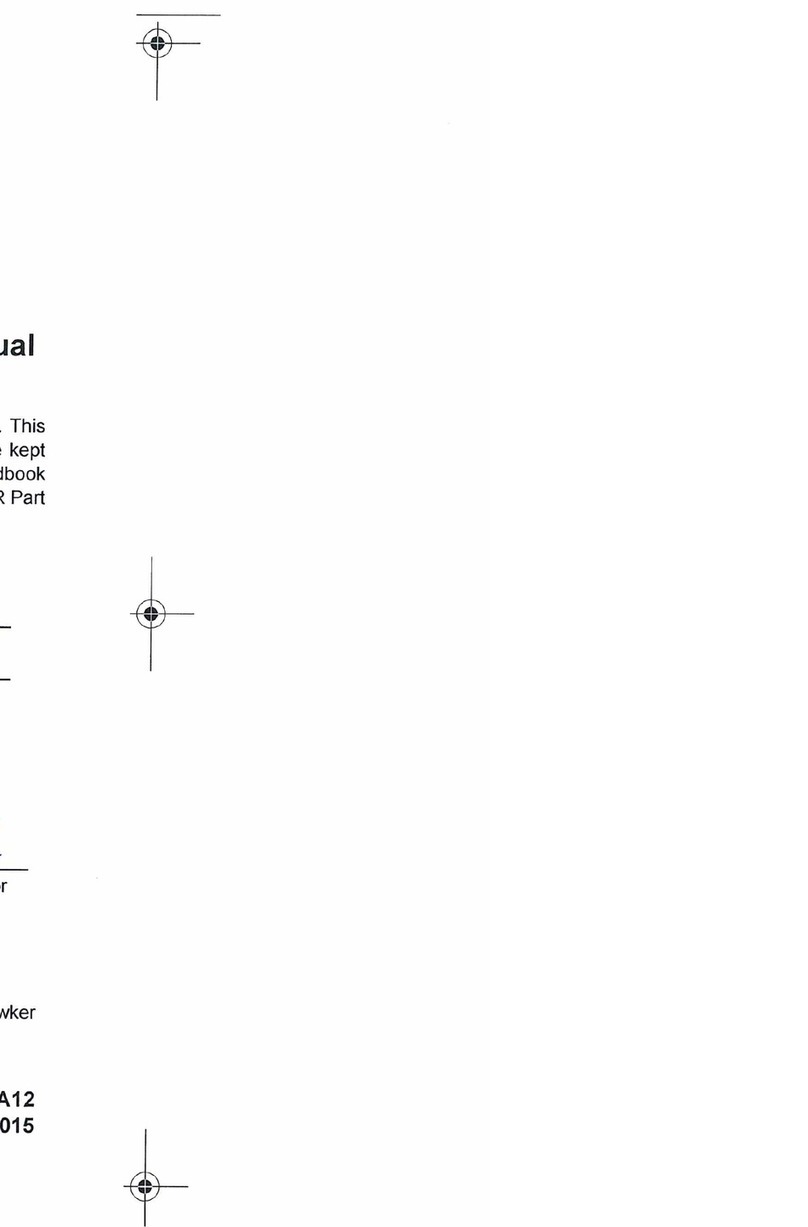
Beechcraft
Beechcraft Baron G58 Owner's manual
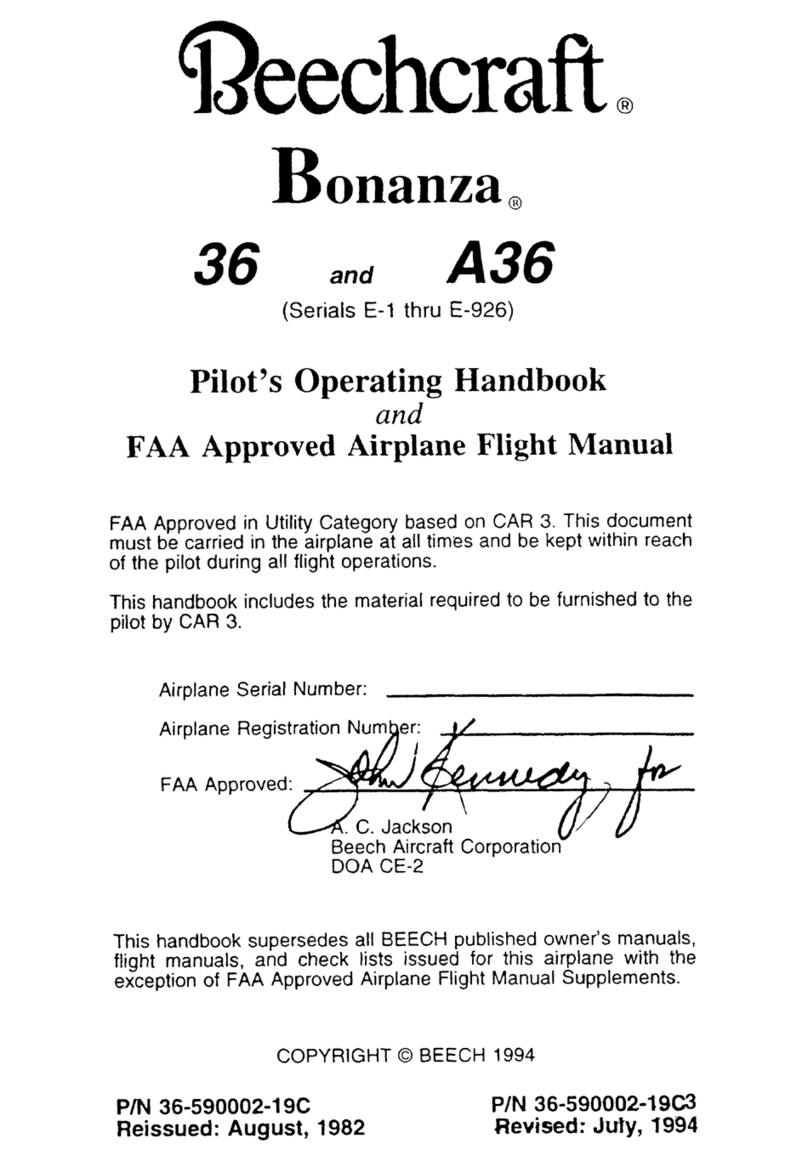
Beechcraft
Beechcraft Bonanza 36 Owner's manual

Beechcraft
Beechcraft Debonair 35-33 Owner's manual
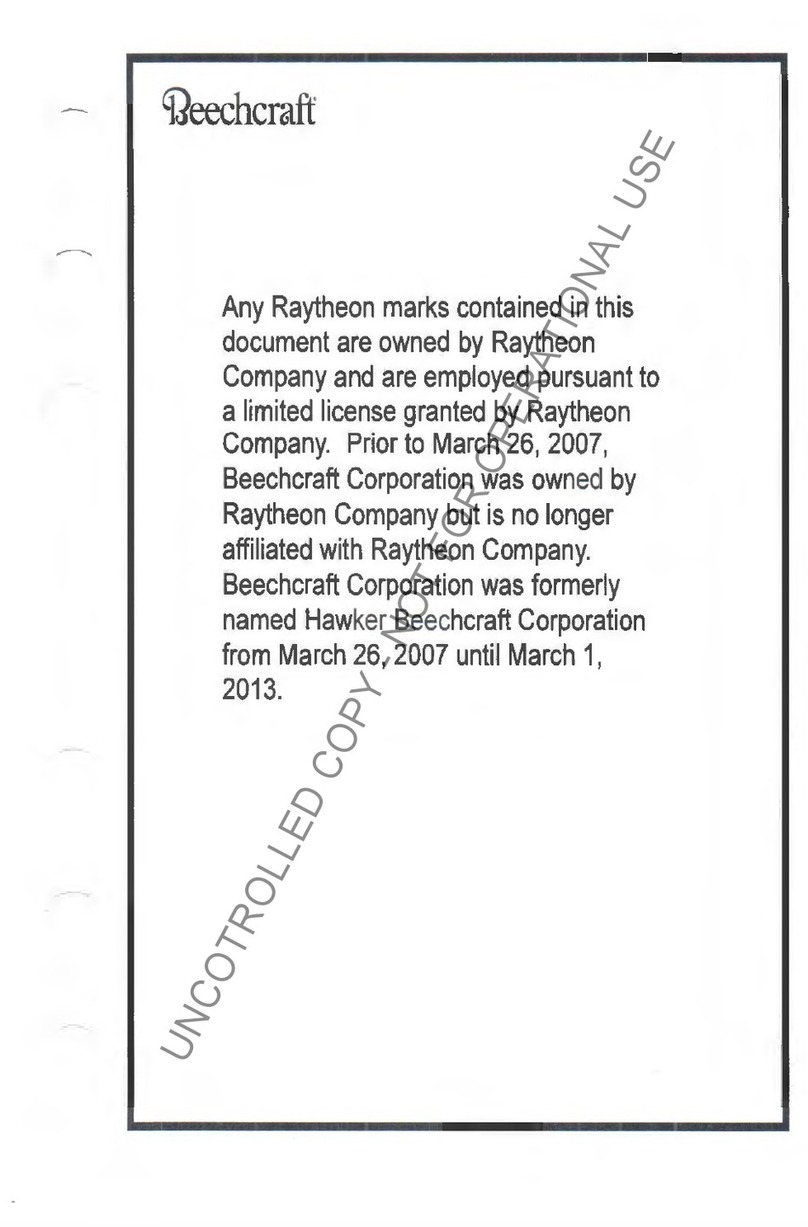
Beechcraft
Beechcraft Musketeer Sport III A23-19 Owner's manual
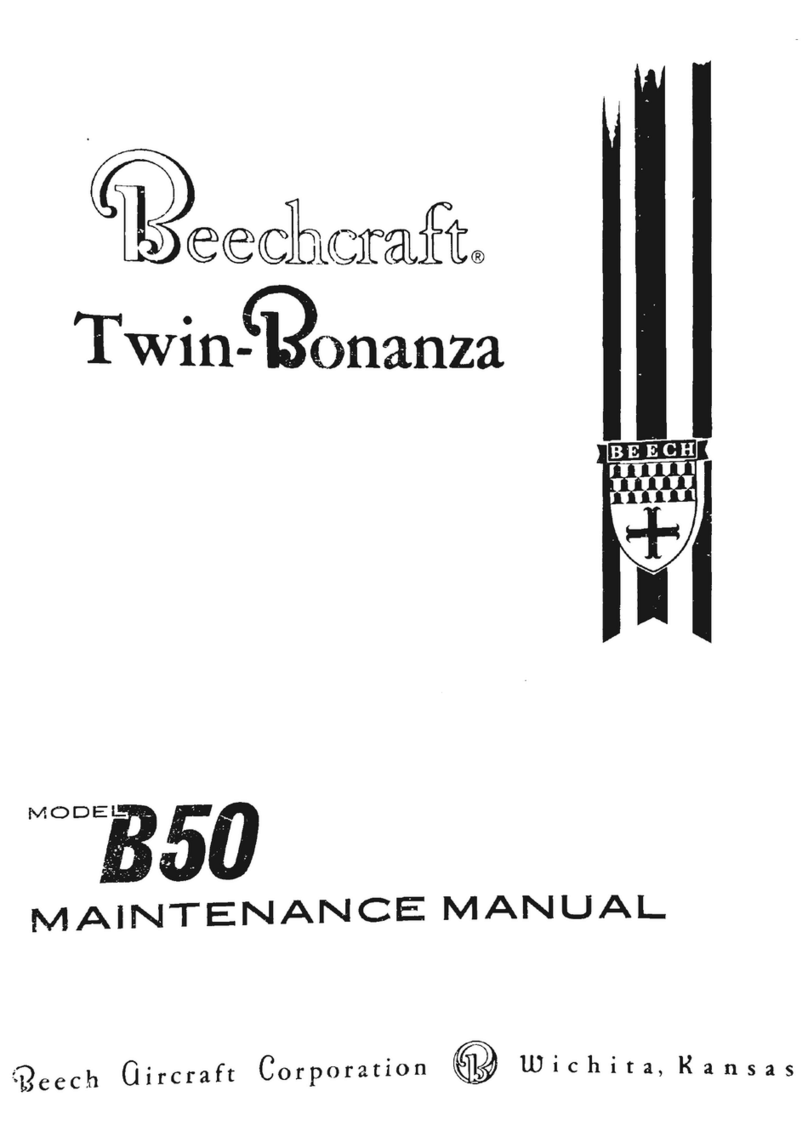
Beechcraft
Beechcraft Twin-Bonanza B50 User manual
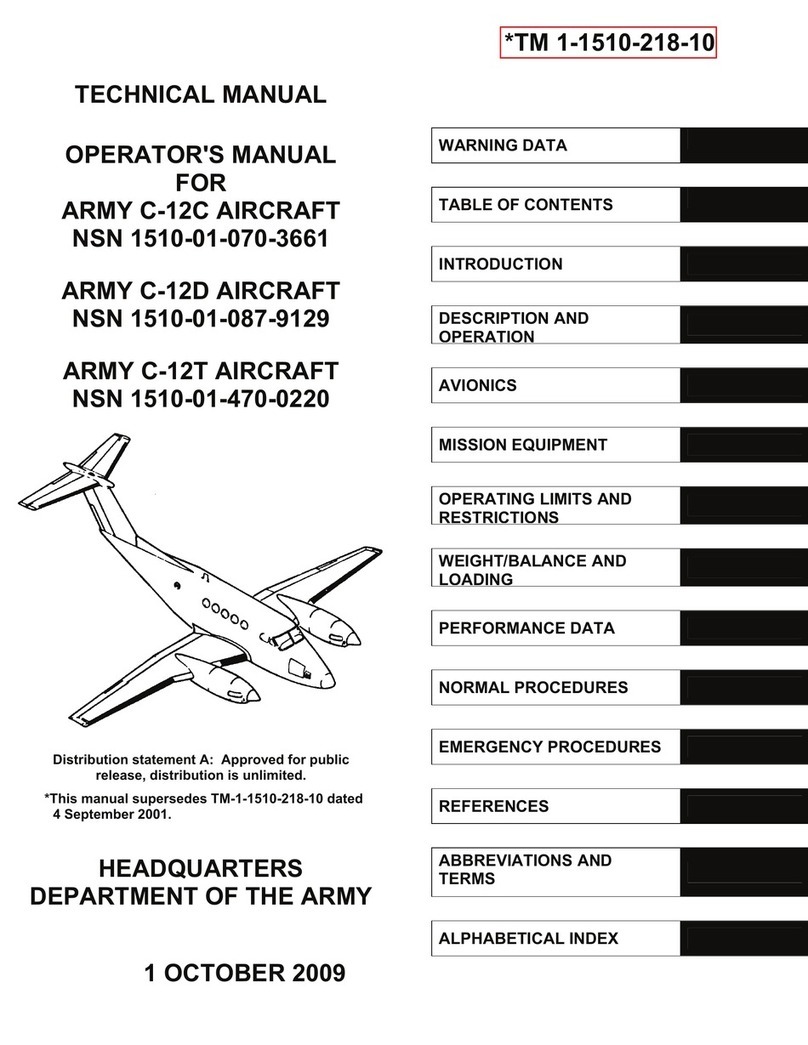
Beechcraft
Beechcraft C-12C Use and care manual
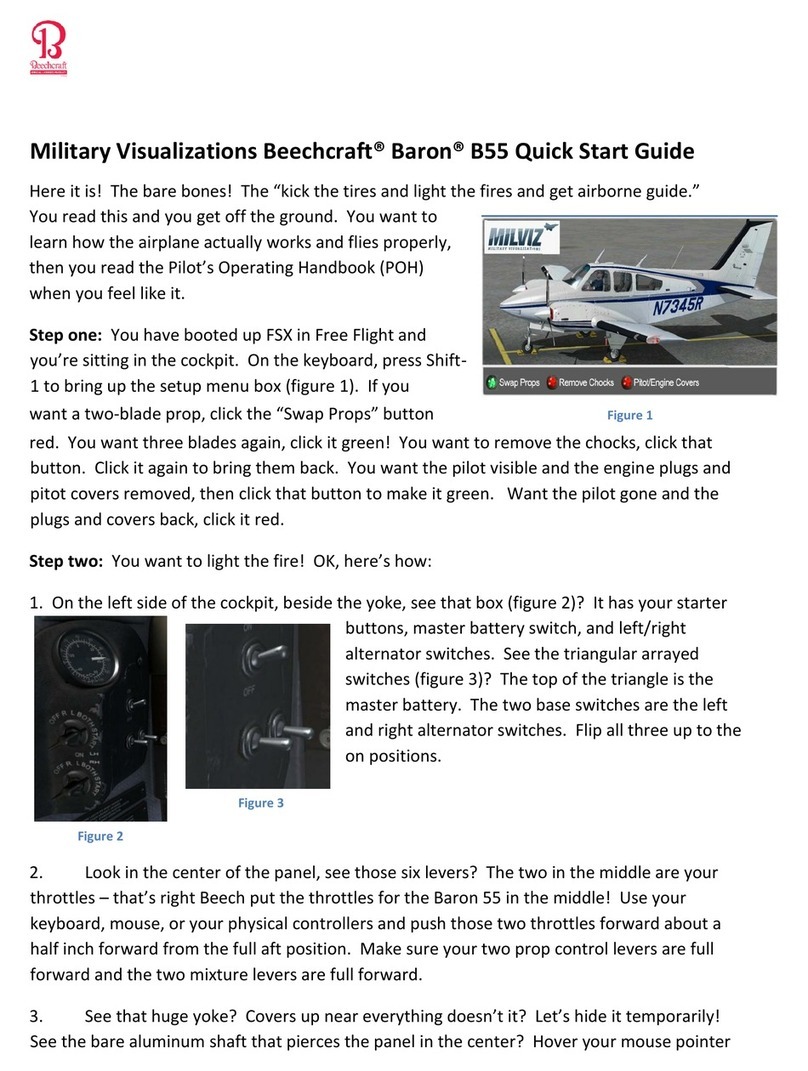
Beechcraft
Beechcraft Baron B55 User manual

Beechcraft
Beechcraft TRAVEL AIR 95 Install guide

Beechcraft
Beechcraft Duke 60 Series User manual
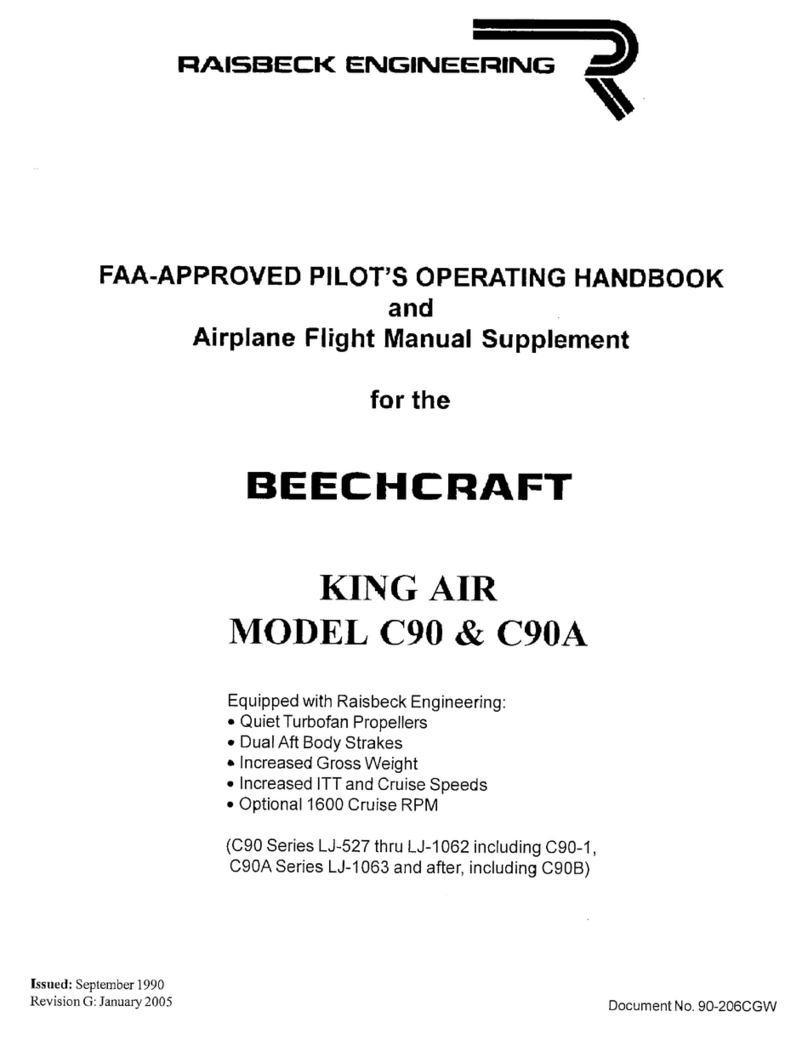
Beechcraft
Beechcraft KING AIR C90 Owner's manual
